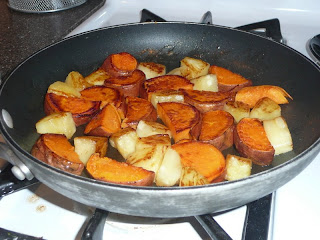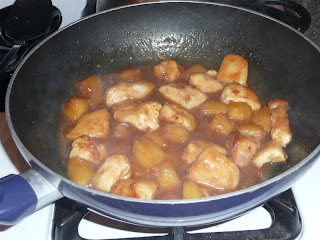

For a family holiday dinner I decided to branch out of my comfort zone for desserts. This is not generally a good idea for say, Thanksgiving dinner or _the_ Christmas dinner for your family, but since we had about 5 "Christmas Dinners" throughout the season I figured risking an utter disaster wouldn't "ruin Christmas." For this particular dinner the main course was take-out pizza, so I could spend my full culinary creative juices on these desserts.
The bread pudding sounded appropriate because I was also making homemade egg nog and the two share cream, eggs, nutmeg and bourbon for ingredients. So, basically, bread pudding is eggnog soaked bread. I found the recipe from a new cookbook I got for Christmas by the makers of Cooks Illustrated Magazine (which is fantastic, btw). The book does a great job of explaining why they chose to do things the way they do instead of just telling you what to do. I didn't want to go completely plain with the pudding, and they suggested you could add raisins, but I went with craisins, thinking the red color was slightly more festive looking and I just like them better.
To make bread pudding you make a custard mixture of eggs, cream and flavorings and then soak chunks of bread in this mixture and bake it.
The two tricky parts to the equation are the ratio of bread to custard and when to put it from the oven. I think the recipe did well on both accounts, although I went with their suggestion of weight for the bread, not volume. They said only 6 cups of bread cubed and when I measured that out it was clearly not enough, but the 12 oz of bread seemed right- it just came out to almost 12 cups in volume. That could be accounted for in a difference in size for the cubes and type of bread, which is why I think weight was a better way to know how much bread to use. It will look like you have way more liquid than you need, but the bread will soak it up and you want that, otherwise it won't be a custard in the end, it will be bread chunks that are moistened- more like french toast (although if you do french toast _really_ well, it should be more like bread pudding in the center of the toast).
Next came deciding when to pull it out of the oven. Too soon, and you have uncooked eggs. Too long, and you have a dried out dessert that isn't really a custard anymore. The book explained that you want it to "jiggle like a jello mold" when you pull it out. You want that wiggle room (ha!) when you take it out to account for carry-over cooking that continues to happen after it's on your counter. (Same thing if you take scrambled eggs out of the pan when they are done to your liking, they will be overdone by the time you take your first bite). This explanation of the finished product worked very well for me and the pudding was super moist and a serving of custardy goodness. I will definitely be making this again!
The poached pears came from a greeting card recipe that my mom sent me. I thought it would be a nice balance with the heaviness of the bread pudding (there's a lot of cream and eggs in that recipe). I have never poached fruit before, but have seen how elegant whole poached pears look in magazines for holiday tables. This recipe called for either red wine or cranberry juice to poach in and since the bread pudding had bourbon in it, I decided to go for the alcohol-free option for this dessert. I think it made for a sweeter result and the cranberry juice was a beautiful colored syrup on the finished product. I used a melon baller to take out the cores of the pears from underneath, peeled them, and put them in a pot just big enough to hold them all standing up. Pull the pears out of the cooking liquid when a knife goes easily through, but before they are mushy, then reduce the liquid to make a syrup for serving and voila! I had planned on keeping them whole because they look so nice standing up in a circle on the platter, but didn't think most guests would want a whole one (and there weren't quite enough to go around anyway), so I sliced them in half and served laying down. It still looked beautiful with the peels scattered about and the red syrup. This is a very simple, not too heavy (as long as you didn't put too much of my homemade whipped cream on it, that is) and very classy addition to dessert.















































